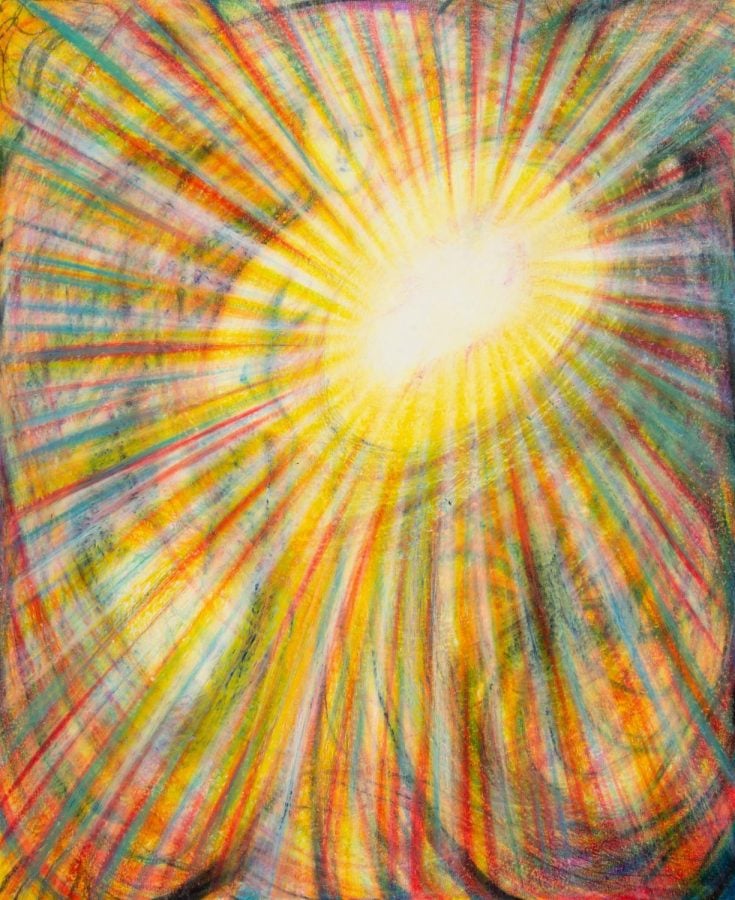Multi-media Evanston artist Lucien Dante Lazar creates art from spiritual base
Courtesy of Lucien Dante Lazar
“The Lyre of Christ” – oil crayon, paper, fixative. A self portrait of Lucien Dante Lazar.
February 25, 2022
Art, for Lucien Dante Lazar, is a deeply introspective, spiritual process. As a result, his work is at once intimate and universal, both for the individual soul and for the collective spirit. His paintings, music and sculptures are outlets for healing and profound reflection.
“My ultimate goal as an artist is to discover the meaning of the human being through art and to discover a relationship with art that can help human beings understand freedom,” Lazar said. “For me, the more multifaceted the artwork becomes, the more it actually integrates into the meaning of the human being, which is a multifaceted organism.”
Lazar grew up in an artistic household and said he was shaped by a Waldorf education. His mother Mary Spalding, a Waldorf teacher, received an M.F.A. from Northwestern in Radio, Television, and Film in 1989, and his father Mark Lazar is a singer-songwriter.
Lucien Dante Lazar and Ultra-Violet Archer, a student at Columbia College studying songwriting, are currently collaborating on an album they expect to release next month.
The album is based on anthroposophy, a spiritual science taught by Rudolf Steiner, the founder of Waldorf Schools, Archer said. She added the pair is primarily using their voices as instruments to create harmony. To Archer, Lucien Dante Lazar’s artwork has a timeless quality.
“He is a visionary without a question,” Archer said. “His art is working out of ancient futurism, which is a term that he made up and that we both really like, because it brings us the quality of something that’s ancient and has been done for thousands of years and then something that is also brand new.”
Lazar engages in many mediums, including sculpture, weaving, painting and drawing. His mom said he has always been interested in creating from raw materials. At Waldorf he learned to knit, crochet and embroider.
“When you’re an artist, you make something from nothing,” Spalding said. “And I would say he was always making something from nothing. He loved the plants. He loved the animals. He always had an eye for beauty.”
Over the years, Lucien Dante Lazar said his artistic inspirations have evolved. When he was younger, cultural aesthetics from around the world inspired him. He was particularly intrigued by high-quality natural materials seen in Celtic, Russian and Indian arts. In his late teens and twenties, his queer identity became important in his work. Now, he explores how art can be a document of spiritual scientific research.
Lazar considers social art pieces — which he calls passages — the culmination of his art. Most passages include sculpture, painting, movement and music, among other art forms.
“I started to realize that they were passages for people,” Lucien Dante Lazar said. “People started to experience them as portals or passages into another quality of consciousness. These passages come out of authentic spiritual(ity).”
Joan of Arc inspired Lucien Dante Lazar’s first passage and continues to be one of his artistic muses.
When Lucien Dante Lazar read Mark Twain’s biography of Joan of Arc, he learned she led the French army at age 17 after hearing the voice of God. He then came to view her as a powerful symbol, and believes she is still very relevant.
“She had a personal relationship with the spiritual world that didn’t need to go through organized religion,” Lucien Dante Lazar said. “And that was very scary to the Church of the time because it gave her so much power.”
Archer said that Lucien Dante Lazar’s art comes from the heart and helps people celebrate the richness of life.
“His art and his music invite people to really feel and accept and celebrate their own splendor,” Archer said. “They evoke this recognition of the richness of the world and the richness of ourselves and give us a moment to really live into that and celebrate it.”
Email: JonathanAustin2023@u.northwestern.edu
Twitter: @JackAustinNews
Related Stories:
— “Still growing”: Ziana “Z” Pearson-Muller pushes boundaries with art
— Alum Matt Irie’s “Arresting Gestures” at Evanston Art Center explores tension between reality and simulation
— Chicago artist Susan Cua integrates Asian heritage into her art



